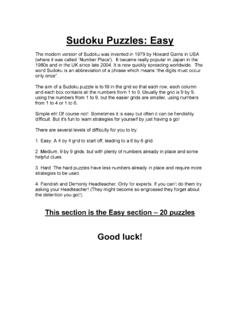Transcription of Sudoku Puzzles Generating: from Easy to Evil - …
1 Team # 3485 Page 1 of 20 Sudoku Puzzles generating : from easy to Evil Abstract As Sudoku puzzle becomes worldwide popular among many players in different intellectual levels, the task is to devise an algorithm that creates Sudoku Puzzles in varying level of difficulty. With the analysis of the game rules, we first define the difficulty level from four aspects as: total given cells, distribution of given cells, applicable techniques of logic deduction and complexity of enumerating search. By the guidance from the definition of difficulty level, the algorithm for generating Puzzles is developed with the dig-hole strategy on a valid grid. Thus, the algorithm developed in two steps: to create a valid grid by Las Vegas algorithm, and then to generating Puzzles by erasing some digits using five operators: z Determine a sequence of digging holes according to the desirable difficulty level, z Set two restrictions to guide the distribution of given cells, z Judge whether a puzzle being dug out has a unique solution by a solver built using Depth-First Search, z Add pruning technique to avoid digging an invalid cell, and z Perform propagating at a dug-out puzzle to raise the diversity of the output puzzle.
2 Using our developed algorithm, we generate Sudoku Puzzles in any five difficulty levels. The difficulty level of output Puzzles can be adjusted by a desirable difficulty value input by players. The complexity of the algorithms in space and time is analyzed to demonstrate the effectiveness of the algorithms. Our main contributions in exploring the dig-hole strategy are summarized as following three works: to do a massive research on the sequence of digging holes and how it affects the algorithm to create a evil-level puzzle with minimal given cells, to invent a skill for judging the solution s uniqueness of a puzzle being dug out by the reduction to absurdity, and to reduce the computational time by avoiding backtracking to an explored cell and refilling an empty cell.
3 Keywords: Dig-hole Strategy, Las Vegas Algorithm, Pruning, Reduction to Absurdity Team # 3485 Page 2 of 20 Contents 1 Sudoku is Hot ..3 How to Play ..3 2 Problem Our Related Basic 3 Assumptions and 4 Metrics of Difficulty 5 Specification of Solving Algorithm: Depth first generating Creating Terminal Pattern: Las Vegas Digging 6 7 Analysis of Algorithm 8 Strengths and 9 Team # 3485 Page 3 of 20 1 Background Sudoku is Hot Sudoku puzzle, as a widely popular intellectual game in recent years, was invented in Swiss in 18th century. Then, it initially harvested well development in Japan in the past decades.
4 The name Sudoku actually derives from Japanese that means number place [1]. Due to its simple and friendly rules for beginners and the charm from intellectual challenge, Sudoku becomes welcome recently for players of various ages. You are even able to solve a Sudoku puzzle easily without any mathematical knowledge. How to Play How is the Sudoku game played? You only need to know where you play the game and what your goal is. The both simple aspects that help you join the game are specified as follows: z Game Environment: you may first get a general overview of this game board in Figure Figure : General view of Sudoku game environment We define several basic components of the board as Figure illustrates.
5 The whole board is actually a 9-by-9 grid made of nine smaller 3-by-3 grids called blocks. The smallest unit square is called a cell which has two types of states: empty, and confirmed by a digit from 1 through 9. We mark the whole gird with rows and columns from top-left corner. Team # 3485 Page 4 of 20 z Goal of the Game: generally, Sudoku game is started with such a situation in grid that some of the cells have already been confirmed by digits known as givens. The task for Sudoku players is to place a digit from 1 to 9 into each cell of the grid, and meanwhile each digits can only be used exactly once in each row, each column and each block.
6 Additionally, all the nine rows, nine columns and nine blocks are respectively ensured to contain all the digits from 1 through 9. These limitations for placing digits in three locations are respectively called row constraint, column constraint and block constraint. Based on the rules that we mentioned above, Sudoku players are commonly inspired to complete the placement of digits into all empty cells using various techniques as soon as possible. 2 Problem Analysis Our Tasks Since Sudoku game is hugely attractive for worldwide players in different intellectual levels, it is significantly necessary for researchers to create Puzzles tailored to the difficulty requests of players in a tolerable time.
7 Meanwhile, these created Puzzles must yield a unique solution so that players can complete the Puzzles based on confirmed cells using logic-deducing step by step. A puzzle with unique solution also shows sufficient intellectual challenges in the pursuit of terminal answer, and highlights the inherent charm of Sudoku game. Thus, we develop an algorithm to construct specific Sudoku Puzzles with the consideration of the following three requirements: 1. Varying difficulty: essentially, the algorithm should be able to create Puzzles in different levels of difficulty. It regulates that the algorithm for creating must be designed by means of two jobs as follows: z Difficulty level: define what the difficulty level is, and evaluate a fixed Sudoku puzzle by a grading algorithm.
8 Z Extensibility: a varying number as a metric of difficulty request from a play can be input by the player. Based on this number, the algorithm for creating must be applicable to generate diverse Puzzles satisfying the difficulty request of the player. 2. Unique solution: all generated Sudoku Puzzles must be guaranteed to yield a unique solution by a solving algorithm. 3. Minimizing complexity: the programs of all these algorithms must finish their jobs in a short time accepted by users or players. Team # 3485 Page 5 of 20 In sum, we need to solve the entire problem of creating Sudoku Puzzles by developing the three algorithms respectively for solving, grading and generating .
9 Related Works By reviewing the history of Sudoku development, Sudoku Puzzles grow up from an intellectual game for humans to a challenging problem for algorithm development with the participation of computer science. A famous demonstration in [2] claims that the total number of valid 9-by-9 Sudoku grids is 6,670,903,752,021,072,936,960. Another powerful conclusion shows that the minimal amount of givens in an initial Sudoku puzzle that can yield a unique solution is 17 given cells [3]. Recently, researchers engaged in algorithm development issues some breakthroughs in Sudoku solving, grading and generating by Genetic Algorithm, evolutionary method with geometric crossover, belief propagation etc.
10 [4], [5], [6]. Amount these algorithms, the simplest and easiest one for implementation of generating Puzzles is digging-hole method. The idea of this method begins with a valid grid that seems the same as a terminal pattern of puzzle. Then, a fixed amount of confirmed cells are dug into empty cells by some mechanism or sequence. While a confirmed cell is dug out, the remaining pattern of grid as an incomplete puzzle must be judged whether the puzzle can yield a unique solution. The difficulty level is mainly determined by the amount of empty cells. Basic Ideas Our generating algorithm stands on the shoulders of giant who initially proposed the idea of digging holes. In this paper, our main efforts are paid to research how to dig holes.



